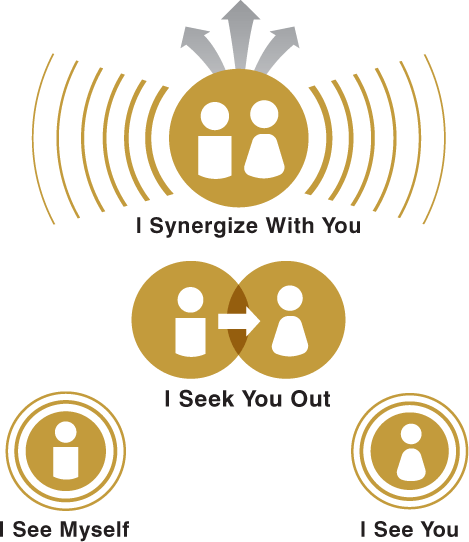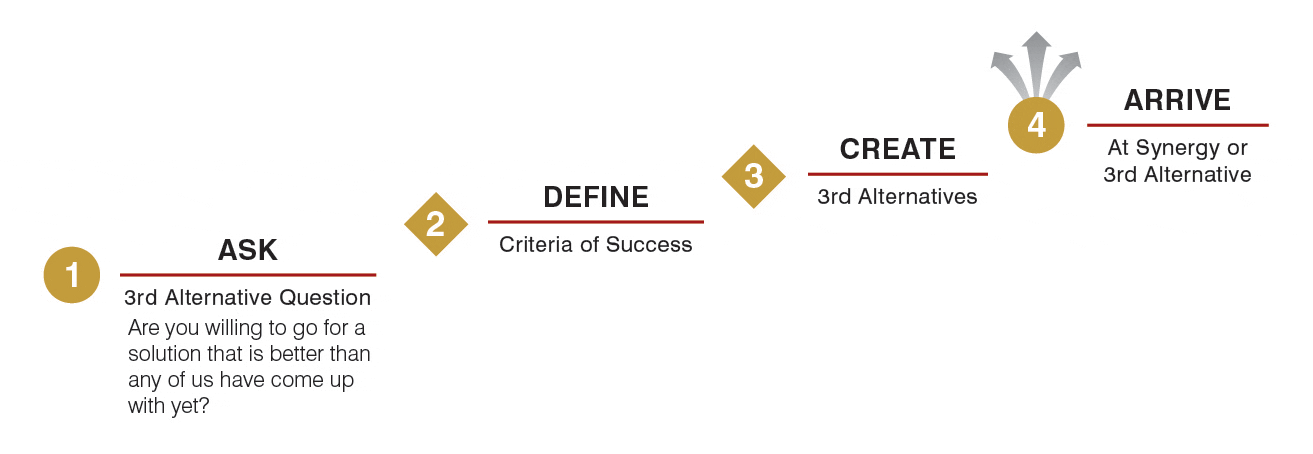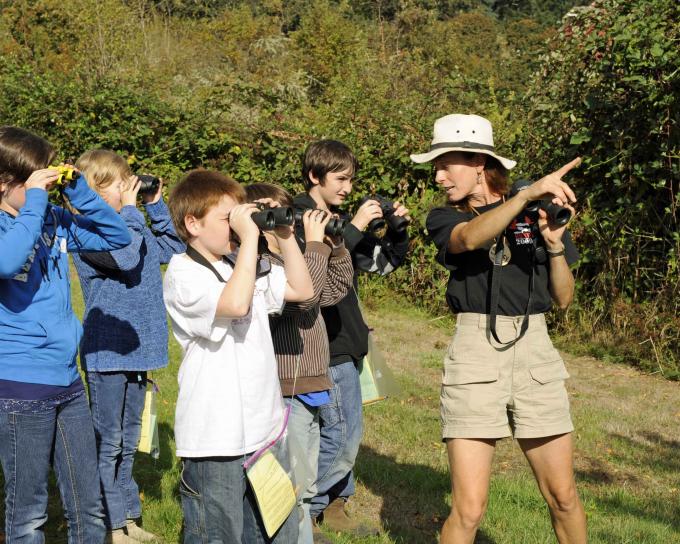Embracing 3rd Alternatives
Author: Betsy Wierda
September 8, 2016

This is post written by Betsy Wierda, Educational Coach and consultant at FranklinCovey, and Edie Jarrell, principal and Learning Leader at Wards Creek Elementary School in St. Augustine, Florida.
Embracing 3rd Alternatives in the Schoolhouse
Stephen R. Covey, in his renowned book The 3rd Alternative (2011), tells us that 3rd Alternatives are a breakthrough approach to conflict resolution and creative problem solving. Dr. Covey begins with synergy and takes us beyond “my way” or “your way” to a new way—a better way.
We know that conflict resolution is needed in any organization, and in the school setting, it is oftentimes a big part of our job. We teach our children how to solve conflicts and learn from them. Unfortunately, however, many of these strategies are low-level accommodations that put a metaphoric “Band-Aid” on a problem that is only temporarily solved.
How do we as educators move past these low levels of problem solving and truly help our staff and our children embrace creative problem solving, develop a new sense of excitement around conflict, and dig deeper to create a culture that embraces the risk taking involved in encouraging wild ideas? No easy feat, but certainly worth it!
Perhaps through modeling, explicit and implicit teaching, and creating a risk-free environment where failure is embraced as an opportunity and where diversity extends past tolerance to value, we can teach our children the beauty and power of 3rd Alternatives.
What Is True Synergy?
 To put it simply, synergy means “two heads are better than one.” Synergize is the habit of creative cooperation. It is teamwork, open-mindedness, and the adventure of finding new solutions to old problems. But it doesn’t just happen on its own. It’s a process; and through that process, people bring all their personal experience and expertise to the table. Together, they can produce far better results than they could individually. Synergy lets us discover, jointly, things we are much less likely to discover by ourselves. It is the idea that the whole is greater than the sum of the parts: 1 + 1 = 3, or 6, or 60—you name it.
To put it simply, synergy means “two heads are better than one.” Synergize is the habit of creative cooperation. It is teamwork, open-mindedness, and the adventure of finding new solutions to old problems. But it doesn’t just happen on its own. It’s a process; and through that process, people bring all their personal experience and expertise to the table. Together, they can produce far better results than they could individually. Synergy lets us discover, jointly, things we are much less likely to discover by ourselves. It is the idea that the whole is greater than the sum of the parts: 1 + 1 = 3, or 6, or 60—you name it.
When people begin to interact genuinely, and they’re open to each other’s influence, they begin to gain new insight. The capability of inventing new approaches is increased exponentially because of their differences.
Valuing differences is what really drives synergy. Do you truly value the mental, emotional, and psychological differences among people, or do you wish everyone would just agree with you so you could all get along? Many people mistake uniformity for unity—sameness for oneness. How boring! Differences should be seen as strengths, not weaknesses. They add zest to life.
How Do Adults Move From Synergy to 3rd Alternatives?
When I envision synergy, I see everyone with a puzzle piece. Each person adds his or her piece to create the beautiful picture. If one piece is missing, it is very evident and impacts the overall appearance. Synergy makes a big job easier, and everyone’s contribution is combined to create success.
A school-based example of synergy is our second-grade historical museum. Each student chooses a famous person to research, and he or she becomes a “wax figure” of that person. When guests push the wax-figure “start” button, they learn about that leader and the contribution he or she made in history. When you see 150 students in the museum portraying a famous person, it is an amazing image of synergy.
I see the 3rd Alternative as the framework to invent new solutions that haven’t even been thought of before. This creative process allows all stakeholders to carve a piece of the path to an undiscovered outcome. In an environment where everyone feels safe to share ideas, the 3rd Alternative can be a fun process. You are actually creating something new, not selecting from a list of current options.
An example that occurred most recently was born out of a need to address equity of planning time among all staff members. There really was not a simple solution, so everyone involved had to offer individual ideas, then as a team, we built a schedule that was even better than anything we have done in the past. Ironically, we were concerned that changes would impact student-contact time; but actually, it created more time and a more systemic schedule for everyone. And because all voices were heard, the attitude of each person impacted by the solution was positive, with their buy-in, guaranteeing success.
It is the challenge that creates the opportunity for victory. If we can independently function without the need for others, we do not seek their help or input. We need to relish the challenge and use it as a bridge to create solutions that are a tapestry of everyone’s contribution.
How Can Children Move From Synergy to Understanding and Embracing 3rd Alternatives?
These are exciting times in education. Our standards require students to find their voice, defend their position, and to explain their understanding. This creates an ideal platform for the 3rd Alternative. Rather than helping one another solve a challenge with a given expectation and outcome, students now have the opportunity to create hypotheses and test them with creative, inventive solutions. Can you imagine the freedom of being told, “There are no wrong answers; as a matter of fact, there may not even be a right answer yet, so let’s discover the solution together!”
While they are young and invincible, we need to tap into the creative energy of our students. They do not have a history of failures that have caused them to be intimidated and shrink from challenges. Their curiosity and courage are perfect for taking on unsolved challenges and creating a 3rd Alternative.
How Can We Create a 3rd Alternative Culture?
 Begin by celebrating ideas, no matter how outlandish! Record every thought and look for connections between “what is and what could be.” Encourage imagination and never say, “No.” Instead, say, “Tell me more,” and allow the idea to grow and flow into new thinking. As a school leader, I share the challenges with my staff. I seek their input and look for ways to use everyone’s ideas to create a solution. I don’t pick my favorite solution and run with it. Everyone’s voice should be heard and everyone’s contribution should be included in the solution. When 100 percent of the staff gives their 100 percent, the burden is light and buy-in is incredible.
Begin by celebrating ideas, no matter how outlandish! Record every thought and look for connections between “what is and what could be.” Encourage imagination and never say, “No.” Instead, say, “Tell me more,” and allow the idea to grow and flow into new thinking. As a school leader, I share the challenges with my staff. I seek their input and look for ways to use everyone’s ideas to create a solution. I don’t pick my favorite solution and run with it. Everyone’s voice should be heard and everyone’s contribution should be included in the solution. When 100 percent of the staff gives their 100 percent, the burden is light and buy-in is incredible.
We can also teach students that failure is an opportunity for growth. Our children have been learning how to succeed for years. Have we taught them how to fail, to get back up, to persevere, as well as the real meaning of resiliency? Let’s embrace failure as a part of our culture and learning environment as we create risk-free environments where wild ideas are truly encouraged.
3rd Alternative Outcomes
Imagine your learning community as that safe place to share ideas, to succeed, to fail forward, and to ultimately Synergize and come up with ideas that are even better that those we could think of alone.
Imagine a place where adults and children have no inhibitions about sharing wild ideas or taking risks in order to solve problems. Imagine a strengths-based community where each person’s gifts and talents are celebrated and welcomed.
Let’s embrace synergy and 3rd Alternatives this school year as we leave the beaten path and journey to a place of new discoveries, new levels of achievement, and new purposeful passions.
Share Article on
Tags: 21st century education, 21st century skills, emotional intelligence, leadership culture, leadership lessons, school culture, school environment, student empowerment, student leadership, wellness-leadership, what we're reading, whole-child education
